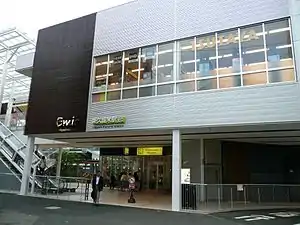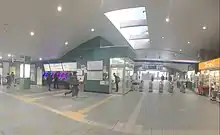Higashi-Kurume Station
Higashi-Kurume Station (東久留米駅, Higashi-kurume-eki) is a railway station on the Seibu Ikebukuro Line in Higashikurume, Tokyo, Japan, operated by the private railway operator Seibu Railway.
SI14 Higashi-Kurume Station 東久留米駅 | |
|---|---|
 Higashi-Kurume Station north entrance, June 2010 | |
| Location | 1-8 Honchō, Higashikurume-shi, Tokyo (東京都東久留米市東本町1-8) Japan |
| Operated by | |
| Line(s) | |
| Platforms | 2 side platforms |
| Connections |
|
| Other information | |
| Station code | SI14 |
| History | |
| Opened | 1915 |
| Passengers | |
| FY2013 | 53,547 daily |
Lines
Higashi-Kurume Station is served by the Seibu Ikebukuro Line from Ikebukuro in Tokyo, with some services inter-running via the Tokyo Metro Yurakucho Line to Shin-Kiba and the Tokyo Metro Fukutoshin Line to Shibuya and onward via the Tokyu Toyoko Line and Minato Mirai Line to Motomachi-Chukagai. Located between Hibarigaoka and Kiyose, it is 17.8 km from the Ikebukuro terminus.[1]


Station layout
The station has two ground-level side platforms serving two tracks.[2]
The "Emio Higashi-Kurume" shopping and eating complex opened in 2010. The station building includes lavatories for men and women and a wheelchair-accessible multi-purpose restroom.
Platforms
| 1 | ■ Seibu Ikebukuro Line | for Nerima and Ikebukuro Tokyu Toyoko Line for Yokohama Minatomirai Line for Motomachi-Chukagai |
| 2 | ■ Seibu Ikebukuro Line | for Tokorozawa and Hannō |
Adjacent stations
| ← | Service | → | ||
|---|---|---|---|---|
| Seibu Ikebukuro Line | ||||
| Limited express: Does not stop at this station | ||||
| Rapid express: Does not stop at this station | ||||
| Express: Does not stop at this station | ||||
| Hōya | Commuter express | Tokorozawa | ||
| Hibarigaoka | Rapid | Kiyose | ||
| Hibarigaoka | Commuter semi express | Kiyose | ||
| Hibarigaoka | Semi express | Kiyose | ||
| Hibarigaoka | Local | Kiyose | ||
History
Higashi-Kurume Station opened on 15 April 1915.[1] It was named Higashi-Kurume to avoid confusion with Kurume Station in Kyushu.[2]
The station was rebuilt in 1994 with a new structure spanning the tracks and platforms.[2]
The "Emio Higashi-Kurume" station complex opened in 2010.[2]
Station numbering was introduced on all Seibu Railway lines during fiscal 2012, with Higashi-Kurume Station becoming "SI14".[3]
Through-running to and from Yokohama and Motomachi-Chukagai via the Tokyu Toyoko Line and Minatomirai Line commenced on 16 March 2013.[4]
Passenger statistics
In fiscal 2013, the station was the 17th busiest on the Seibu network with an average of 53,547 passengers daily.[5]
The passenger figures for previous years are as shown below.
| Fiscal year | Daily average |
|---|---|
| 2000 | 47,264[1] |
| 2009 | 52,302[6] |
| 2010 | 52,275[7] |
| 2011 | 51,808[8] |
| 2012 | 52,520[5] |
| 2013 | 53,547[5] |
Surrounding area
- Higashikurume City Office
- Higashikurume Fire Station
References
- Terada, Hirokazu (July 2002). データブック日本の私鉄 [Databook: Japan's Private Railways]. Japan: Neko Publishing. p. 201. ISBN 4-87366-874-3.
- Kawashima, Ryozo (March 2011). 日本の鉄道 中部ライン 全線・全駅・全配線 第12巻 東京都心北部 [Railways of Japan - Chubu Line - Lines/Stations/Track plans - Vol 12 Northern Central Tokyo]. Japan: Kodansha. p. 32/65. ISBN 978-4-06-270072-6.
- 西武線全駅で駅ナンバリングを導入します [Station numbering to be introduced at all Seibu stations] (PDF). News Release (in Japanese). Japan: Seibu Railway. 23 February 2012. Archived from the original (PDF) on 24 September 2015. Retrieved 10 February 2013.
- 東急東横線・メトロ副都心線相互直通、16日スタート [Tokyu Toyoko Line and Tokyo Metro Fukutoshin Line inter-running to start on 16 March]. Nikkei.com (in Japanese). Japan: Nikkei Inc. 15 March 2013. Retrieved 2 April 2013.
- 駅別乗降人員 2013(平成25)年度 1日平均 [Average daily station usage figures (fiscal 2013)] (PDF) (in Japanese). Japan: Seibu Railway. Archived from the original (PDF) on 14 July 2014. Retrieved 22 June 2014.
- 駅別乗降人員 2010(平成22)年度 1日平均 [Average daily station usage figures (fiscal 2010)] (PDF) (in Japanese). Japan: Seibu Railway. Archived from the original (PDF) on 26 June 2011. Retrieved 26 January 2013.
- 各駅の乗車人員 (2010年度) [Station passenger figures (Fiscal 2010)] (in Japanese). Japan: East Japan Railway Company. Archived from the original on 6 October 2014. Retrieved 26 January 2013.
- 駅別乗降人員 2011(平成23)年度 1日平均 [Average daily station usage figures (fiscal 2011)] (PDF) (in Japanese). Japan: Seibu Railway. Archived from the original (PDF) on 1 November 2012. Retrieved 26 January 2013.
External links
| Wikimedia Commons has media related to Higashi-Kurume Station. |
- Higashi-Kurume Station information (Seibu Railway) (in Japanese)